ISSN ONLINE(2319-8753)PRINT(2347-6710)
ISSN ONLINE(2319-8753)PRINT(2347-6710)
Sachudhanandan.s1, Udayakumar P A2, Ramalingaiah3
|
| Related article at Pubmed, Scholar Google |
Visit for more related articles at International Journal of Innovative Research in Science, Engineering and Technology
Polymer Matrix Composites( PMC) are gaining more importance compared to the monolithically materials as being more reliable and cheap Polymer matrix composites are finding applications from household to engineering approach. With the advancement of PMCs their properties can be increased by the addition of one more fiber made as hybrid composite which boosts the property of PMC where a single fiber composite lags. In our project we have chosen rice husk as the major reinforcement and aramid as an additional fiber to improve the mechanical property of polymer composite with vinyl ester as the base material prepared by hand lay-up process according to ASTM standards. Test specimens are prepared with different weight fractions of rice-husk at the optimization point of tensile test a small percentage of aramid are added and tests were conducted and the improvement in mechanical properties (tensile strength and flexural strength) of the hybrid composite material is observed.
Keywords |
| Vinylester, Rice Husk, aramid, Hybrid Polymer Composite, Tensile and Flexural Strength |
INTRODUCTION |
| Natural polymers are more in concern in the research work as they are naturally and abundantly available and cheap compare to synthetic fiber. Rice husk is used more as a fuel for burning and to some extent its ash is used as admixture in concrete making rather it can be used to prepare a composite to enhance the property of a matrix material which is made available for various applications that may be industrial, constructional, or automotive area. Hardinnawirda [1] studied that with the addition of rice husk filler there is decrease in tensile strength of the composite and its water absorption increases as it absorbs water. D Lingaraju [2] studied on rice husk ash Nano composite using burnishing processes which is increased the hardness of composite material with the increase of depth cut and also smoothen the surface, Treated RHA has good influence on hardness than non-treated RHA.Francis Uchenna OZIOKO studied The effect of carbonization temperatures on wear rate behaviours of different volume fractions of rice husk ash epoxy composite. Wear rate and specific wear rate behaviours of different samples have shown near uniform behaviour. The 950°C carbonized ash showed steady wear rate and specific wear rate behaviour for all ash contents. Dimzoski [4] Studied properties of rice-hull-filled polypropylene (PP) composites. Using the concept of linear elastic fracture mechanics, Introduction of rice hulls in the PP matrix resulted in a decreased stress at peak , together with increase of composites tensile modulus and modulus in flexure |
| D.Shivaprasad [5] studied As the percentage of RHA particles increases, the density of the composites decreases and there is slight increase in the hardness were observed.Sudhakar Majhi [6] studied that the abrasive wear rate decreases with addition of rice husk fibers as the sliding distance increases for all wt.% of fibers including pure epoxy. It is also observed that 10wt%fiber shows least wear rate. Higher wt.% of fiber also shows lower wear rate but higher than 10wt%, still lower than pure epoxy.Han-Seung Yang [8] The tensile strength and modulus of the bio composites fabricated using the twin-screw extruding system were improved as compared with those fabricated using |
| the single-screw extruding system, due to the improved dispersion of the fillers in the composite. There was no difference in the Izod impact strength of the composites fabricated using the twin-screw and single-screw extruding systems.Patricio Toro[11] the increase of the rice-husk charge as a natural filler in the PP matrix decreases the stiffness, and in the presence of PP-g-MMI as compatibilizer in PP/rice-husk, the tensile modulus and water absorption of the composite were improved. In this study two natural fibers (coir and rice husk) are used to prepare a hybrid material to enhance the property of composite which contains only one fiber and fails to give mechanical strength at particular percentage addition of fiber from that point of yield one more fiber (rice husk) is added to increase its property further to some extent. The fabrication process is hand layup and mechanical tests are tensile and flexural. |
EXPERIMENTAL WORK |
A.Preparation of test samples |
| Finely milled rice husks were collected from a local rice mill. The milled rice husks contain many impurities like dust, small rice particles, and fine sand particles. Therefore, it needs to be cleaned in order to get pure rice husk. After cleaning with water, the rice husks were dried directly under the sun for 8 hours. Then it were weighted according to the percentage needed (5,10, 15 wt. %). After that, the unsaturated polyester resin and methyl ethyl ketone peroxide (MEPK) catalyst were mixed in a container and stirred well for 3 to 5 minutes. The rice husks were then added gradually and stirred to allow proper dispersion of fibre within the gel like mixture. Before the mixtures were poured inside the mould, the mould was initially polished with a release agent to prevent the composites from sticking to the mould upon removal. Finally, after the mixture had been poured into the mould, it was left at room temperature for 24 hours for fully cured and hardened. The materials used in the present research are tabulated in Table.1 with their properties and suppliers |
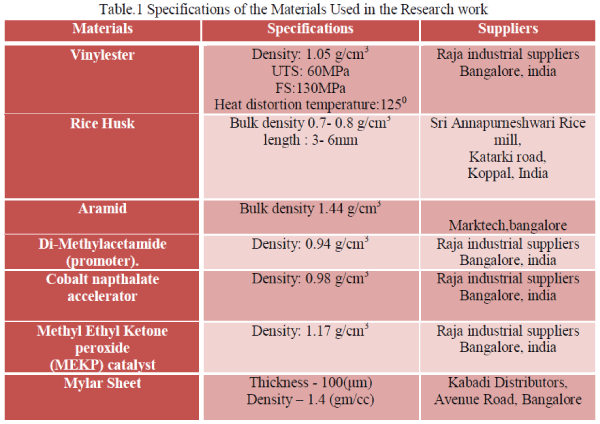 |
B. Processing of Rice Husk and Aramid/Vinylester Composite. |
| Rice husk Composite is prepared first to know at what percentage of weight fraction the composite gives the UltimateTensile Strength from that percentage some percentage of aramid is added to enhance its tensile property. First make some sample preparation calculation before preparing the composite as given below and start the fabrication by preparing the temporary mould using beadings arranged on the granite base representing a rectangular mould of 300x200x5mm. Pour the calculated amount of resin with thoroughly mixed Promoters, Accelerators & Catalyst of 1% to the mould and wait for ten minutes so that it starts pre hardening then put a Mylar sheet on to it and then apply pressure by placing a concrete block over the setup for 24 hours to complete cure the laminate and once the laminate is completely cured then it’s ready for machining according to ASTM standard for testing, repeat the procedure by adding 5, 10, 15% wt of rice husk to the resin. At optimum percentage then add 3, 5, and 7% of aramid and repeat then same procedure to get the Hybrid composite and is tested for mechanical properties |
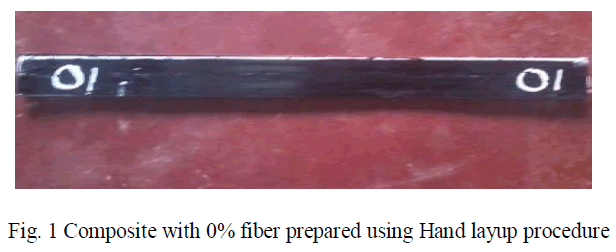 |
| Fig.1 shows the 100% vinyl ester composite is prepared using hand layup process, the unsaturated polyester resin and methyl ethyl ketone peroxide (MEPK) catalyst were mixed in a container and stirred well for 3 to 5 minutes. Before the mixtures were poured inside the mould, the mould was initially polished with a release agent to prevent the composites from sticking to the mould upon removal. Finally, after the mixture had been poured into the mould, it was left at room temperature for 24 hours for fully cured and hardened |
C. Sample Preparation |
| Composite laminate of 300 mm X 200 mm X 5 mm were fabricated according to ASTM standards for mechanical tests. |
| 1) Density of Vinyl ester (δ) = 1.05 g/cm3 |
| 2) Volume of the mold (V) = 300x200 x5mm |
| = 300000mm3 |
| = 300cm3 |
| 3) Mass of resin (m) = Volume of mould x Density of Vinyl ester |
| = 300cm3 x 1.05g/cm3 |
| = 315g |
 |
| Table II. shows sample preparation calculation for Rice husk / vinylester composite, From this table one can observe that as % weight of rice husk of increases, the % weight of of vinyl ester decreases. |
 |
| Table. III shows the Samples Preparation Calculation for Rice Husk& Aramid / Vinylester Hybrid Composite In this case % weight of resin is kept constant and % weight of rice husk and aramid is varied . The above samples are tested for mechanical properties that are tensile and flexural strength according ASTM standards. |
D. Testing parameters |
| A Universal Testing Machine (UTM) is an instrument used for the measurement of loads and the associated test specimen deflections such as those encountered in tensile, compression or flexural modes. It is used to test the tensile ,Compression, flexural and Inter Laminar Shear Strength (ILSS) properties of materials. Load cells and extensometers measure the key parameters of force and deformation as the sample was tested. The Universal Testing Machine set up is shown in Fig.1 |
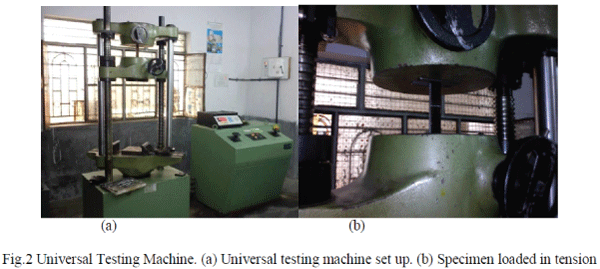 |
a. Ultimate Tensile Strength |
| Ultimate tensile strength, often referred to tensile strength is the maximum stress that a material can withstand while being stretched or pulled before fracture. The tensile test for the specimens was conducted according to ASTM D3039. The specimens of size 250 mm x 25 mm x 5 mm were tested with a span length of 250 mm in tensile mode at a cross head speed of 1 mm / min. The fixtures used for the tensile testing is shown in Fig. 2(b) |
 |
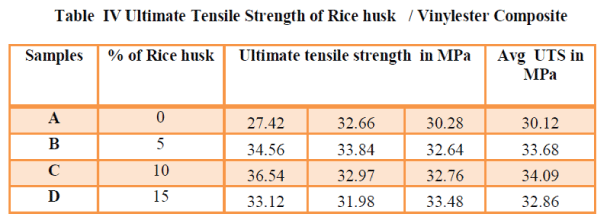 |
| Table IV shows the ultimate tensile strength of rice husk/ vinylester composite, from this table one can observed that the tensile strength is maximum at 10% weight of rice husk. |
 |
| Table V shows the ultimate tensile strength of rice husk& aramid/ vinylester composite From this table one can observe that the maximum tensile strength is at 5 % weight rice husk and and 5% weight of aramid. |
 |
b. Flexural Strength |
| The use of flexural tests to determine the mechanical properties of polymeric composites is widely prevalent because of the relative simplicity of the test method, instrumentation and testing equipment required. The flexural strengths of the specimens were determined for specimens using the three-point bending test as per ASTM-D790. The specimens of dimensions 200 mm x 15 mm x 5 mm tested with a span length of 50 mm. |
| The flexural strength and Modulus of the composites were determined using the equation (1) & (2) respectively. |
 |
C . Lexural Strength Rice Husk / Vinylester Composite |
| The use of flexural tests to determine the mechanical properties of polymeric composites is widely prevalent because of the relative simplicity of the test method, instrumentation and testing equipment required. Table VI & VII.List the flexural strength of Rice husk / Vinyl ester composite & Rice Husk Aramid /Vinylester composite |
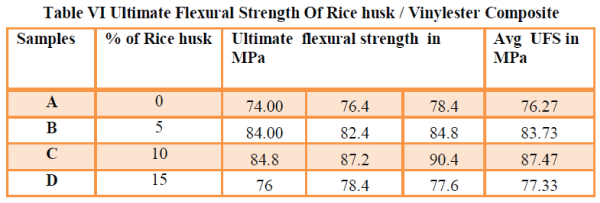 |
| From the table VI one can observed that the maximum Flexural strength at 10 % weight of rice husk loading |
 |
| Table VII shows the ultimate strength of Rice husk & aramid vinylester composite. From this table one can obseve that maximum flexural strength is at 5% Rice husk and 5% Aramid loading. |
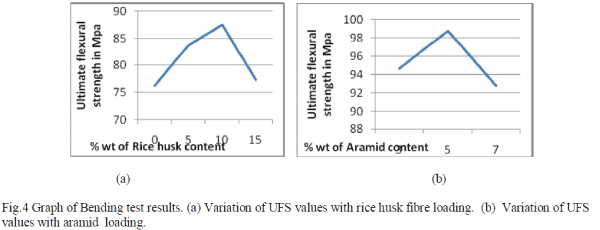 |
SIMULATION & RESULTS |
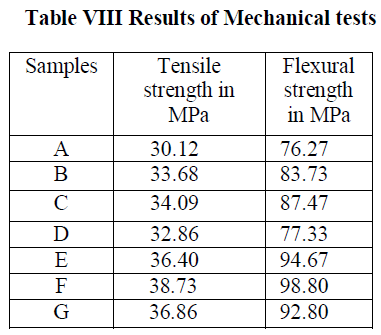 |
| Table VIII shows Results of mechanical tests, in Rice husk/ vinyl ester composite Tensile strength is maximum at sample “C” (90 % vinylester and 10%Rice husk) and in hybrid composite the tensile strength maximum at sample ” F “(90%vinylester,5%rice husk&5%aramid). |
| Flexural strength is maximum at sample “C” (%vinyl ester and 10%Rice husk) and and in hybrid composite the Flexural strength maximum at sample “F”(90%vinylester,5%rice husk&5%aramid). |
 |
CONCLUSION |
| The conclusion of the study of Rice & aramid reinforced vinyl ester composite is that there is significant increase in the tensile strength and flexural strength of the composite. |
| 1. With the addition of rice husk to the Vinyl ester the tensile strength increases by 11.65% at 10% fiber loading and decrease at 15% wt of rice husk loading by 8.34% so further addition of rice husk will no longer increases the strength rather it decreases. |
| 2. With the hybridization I.e. by the addition of aramid at optimum point it increase the tensile strength by further 22.23 % hence hybridization successfully yield more strength compare to single fiber loading |
| 3. The flexural rice husk composite increases by 8.90% at 5% coir loading and 12.80 % at 10% rice husk loading. |
| 4. The flexural strength increase further by 22.80% at 5% aramid. |
| 5. Hybridization results a better improvement in tensile strength but more than 5% of aramid is not recommended where the flexural property is needed for the application. |
ACKNOWLEDGMENT |
| I am thankful to the Department of Mechanical Engineering staff and also Prof.Udayakumar P A GSS institute of technology for their support to carry out this research work. |
References |
|